During the 2020-21 season, 22 forwards appeared on the ice for the Columbus Blue Jackets. Despite pre-season optimism, the team bottomed out and finished last in the Central Division. Finishing with the third-fewest goals scored was a major contributing factor. Overall, the Blue Jackets’ forward corps underwhelmed. Let’s take a look at some of the individual performances.
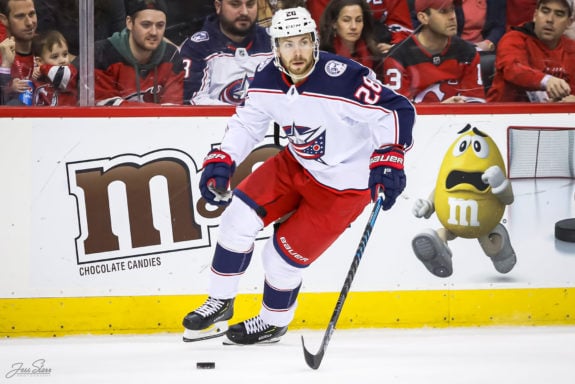
The grading system you’ll find here is based on a combination of factors, including basic statistics (such as goals, assists, plus/minus) and advanced statistics (Corsi, Fenwick, GAR, etc.). Those numbers are then tossed into the blender with subjective factors, such as the “eye test” – how a player looked on the ice during games – and the mitigating factor of the totally unsettled season itself.
Related: Blue Jackets 2020-21 Season: Grading the Defensemen & Goalies
The constant line changes (from game to game and shift to shift) inhibited the formation of chemistry between and among players. That’s not an excuse, but it did contribute to actual results. Grades are also weighted heavily to the last few weeks of the season when many players had more leeway to play to their strengths rather than being shoe-horned into unfamiliar roles.
The Top Dozen Forwards
Only 10 Blue Jackets forwards skated in at least two-thirds of the games in 2020-21 (37 of 56). Two others skated in 30+ games and reached double-digits in points. Here they are, in alphabetical order.
Cam Atkinson: C
Atkinson was tied for second among Blue Jackets players in both points and goals and yet was a bit of a disappointment. I was not the only pundit to predict a “bounce-back” season from Atkinson. His 15 goals in 56 games work out to just about 22 goals in an 82-game season. The season prior, he scored at what again would have been a 22-goal pace (12 goals in 44 games). In the three seasons prior (2016-17 through 2018-19), he scored 100 goals in 227 games, which works out to 36 goals per 82 games. So far in his NHL career (including this season and last), he’s scored at a rate of just under 28 goals per 82 games.
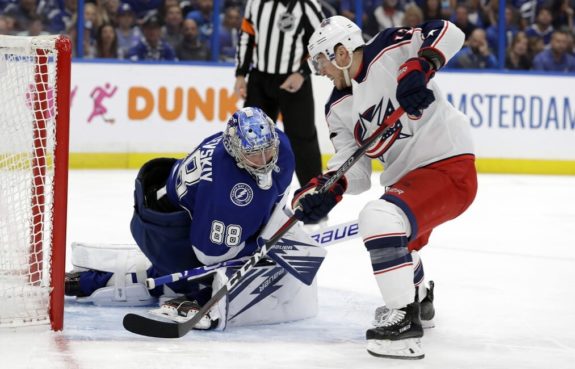
Take a look at Atkinson’s game log for 2020-21, and you’ll see a streaky season. Two goals in his first dozen games. Two goals in his last 20 games. Thirteen goals in the 24 games in between, including a five-game goal-scoring streak in February. Remember, though, that even in his 41-goal season, he had goalless streaks of five games (twice), six games, and seven games – and a second seven-game streak without a goal in the postseason.
But, of course, there is more to a player’s game than scoring goals. He added 19 assists to his 15 goals. 2020-21 was only the second season in his NHL career that his assists outnumbered his goals. The other time? The previous “down” season. And while he finished with a plus/minus of minus-16, he had 31 “plus” or “even” games to his 25 “minus” games.
Overall, though, Atkinson’s role on the Blue Jackets is “goal scorer.” And he fell short. Columbus lost 12 games that went past regulation time – games that could have been won in three periods with one more timely goal. In addition, the team lost another 11 games by one goal or a goal and an empty-net goal (or two). Goal scorers help teams win those close games. That’s not to say that he didn’t score in any of those games, he just didn’t score enough and in enough of them to turn those games around.
Oliver Bjorkstrand: A
Bjorkstrand led the team in goals (18), assists (26), and points (44). Despite the constant change of linemates, he was consistent throughout the season, never going more than three games without a point – and he only went pointless for three straight games twice. Interestingly, he did not have a single game-winning goal. Last season, he also led the team in goals (21) and game-winners (5). In the history of the Blue Jackets, only Bjorkstrand and Rick Nash have led the team in goals in consecutive seasons. His shooting percentage of 12.6% was among the team leaders, as were his total shots on goal.
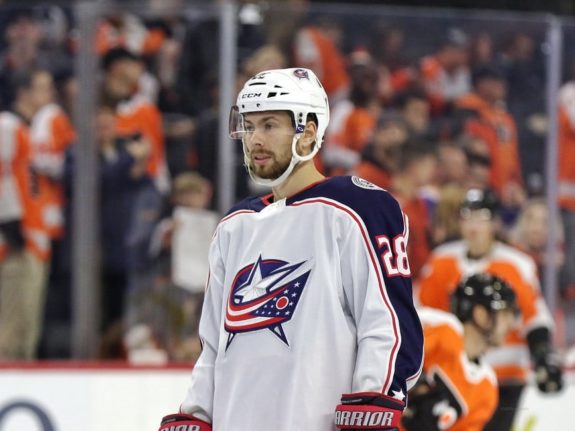
As my colleague Cody Chalfan points out, Bjorkstrand wasn’t just among the best on the Blue Jackets, he was among the best right wings in the league. (And with a contract that pays him $5.4 million for each of the next five seasons, he’s a bargain in terms of goals-per-dollar.) He played every game for the second time in his NHL career and saw a continued increase in his points-per-82-games scoring pace.
Max Domi: C
Domi joined the Blue Jackets in a trade that sent power forward Josh Anderson to the Montreal Canadiens last October. It’s natural to want to compare their 2020-21 seasons. Domi had 24 points in 54 games; Anderson had 24 points in 52 games. It sounds like a good trade, right? Until you notice that Anderson’s 24 points included 17 goals, while Domi had only nine. Okay, then, Domi is a playmaker and Anderson is a scorer, right? After all, Domi is a center and Anderson plays wing, right? Not quite that easy.
Related: Blue Jackets’ Max Domi Making Important Strides
Domi had a rather rough time of it in his first season in Columbus. Expected to be the second-line center, after the first dozen games, he bounced around on the wings for some time. He didn’t actually come into his own until late in the season after the team was out of playoff contention (like several other Blue Jackets). I named him one of the team’s three stars for the month of April. Exactly half of his two dozen points came in April and May after he returned to center. (Look at the number of faceoffs per game to see when he played center and when he was primarily on the wing.)
Nick Foligno: A
Before his trade to the Toronto Maple Leafs, Foligno played in all 42 of the Blue Jackets games, putting up seven goals and nine assists. But there was much more to his game than scoring (as Toronto recognized when they gave up a treasured first-round draft pick as well as a fourth-round pick to acquire him). The former captain was second among Blue Jackets forwards in blocked shots and second among all players in hits. And that’s not on a per-game basis, that’s what he accomplished in only three-quarters of the Blue Jackets’ games. Also, almost 60% of his shifts started in the defensive zone, and three of his assists came during penalty kills.
Mikhail Grigorenko: D
Grigorenko’s return to the NHL after several seasons in the KHL didn’t work out according to his plan. Let’s start with playing time: He appeared in just 32 of 56 games and averaged only 13:45 time on ice. Four goals and eight assists for 12 points in those 32 games don’t scream “First-Round Draft Pick Stars in Return to NHL!” (He was selected No. 12 overall by the Buffalo Sabres in the 2012 entry draft.) Let’s be honest: the Blue Jackets columnists at The Hockey Writers didn’t have high hopes for Grigorenko before the start of the season. Our consensus had him as a fourth-line left wing. In the world of fantasy hockey, our colleague Darren Winkler wrote, “I would classify Mikhail Grigorenko as a deep sleeper. I’m talking a super late-round flyer.”
Boone Jenner: A
Despite playing only 41 games due to a couple of injuries, Jenner was the go-to guy for the Blue Jackets on many nights. His 17 points (eight goals, nine assists) don’t look impressive, but he won over 55% of his 546 faceoffs (the only regular faceoff man over 50%), and among forwards, he was first in blocked shots, third in hits, and third in time on ice.
Patrik Laine: D-
Perhaps nobody was more disappointed in Laine’s performance this season than Patrik himself. Considered the major return in the blockbuster trade that sent Pierre-Luc Dubois to the Winnipeg Jets, he wasn’t even the highest-scoring player coming to Columbus. His 10 goals and 11 assists in 45 Blue Jackets games were extremely disappointing. (I would like to note, however, that Dubois’s 41 games with the Jets produced only eight goals and 12 assists, so Laine actually wasn’t the least productive player in the trade.) In his post-season exit interview, Laine expressed his desire to improve – and to do so in Columbus, even though he will be a restricted free agent:
At the 9:35 point of the interview, Laine says his explanation for his lack of scoring was “I didn’t play well enough.” Laine’s 10 goals were equivalent to 18 in an 82-game season. Over his first four years in the league, he scored at a rate of 37 goals per 82 games. In terms of goal-scoring potential, he’s potentially on a par with former Blue Jacket Rick Nash. But not in 2020-21.
Riley Nash: B
Injured after 37 games and then traded, Nash just barely made the “two-thirds of the games” cutoff for this section. He has never been considered a scoring machine, and he lived up to that this past season with only two goals and five assists. He was, however, a solid third- or fourth-line center for most of the season. If he had won just one more of his faceoffs, he would have ended the season at exactly 50%. If he had been on the ice for just one more goal (by any Blue Jacket), he would have finished the season with a plus/minus of zero. He was expected to be a solid bottom-six forward and he delivered.
Eric Robinson: C+
Here’s a question I posed: “Four Blue Jackets skated in all 56 games. Cam Atkinson, Oliver Bjorkstrand, Seth Jones, and who?” Needless to say, my colleague, Mark Scheig, knew the answer without having to check stats and game logs. He stood alone. No one else knew that the answer was “Eric Robinson.” In fact, a number of people doubted me and one told me to my face that I was wrong. But the numbers don’t lie. His production wasn’t great at eight goals and 10 assists in an average of 12:24 time on ice.
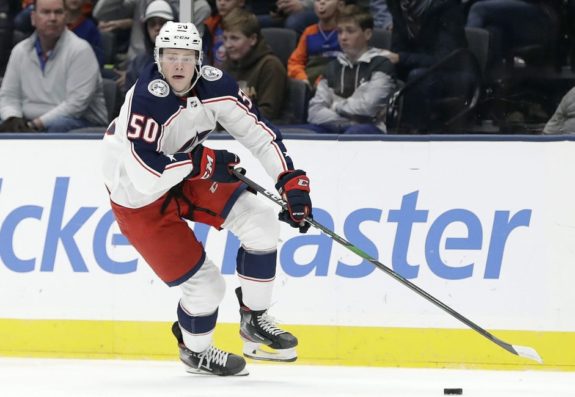
Besides skating in all 56 games, Robinson had some other good numbers on a bad team. His plus/minus of plus-6 was best on the team. His “advanced stats” were also tops among Columbus players with more than 20 games. One other thing: Robinson is fast, perhaps the fastest skater on the team. And he’s learning how to use that speed. Six of his points came in the last seven games of the season, including his only multi-goal game.
Jack Roslovic: B-
Almost an afterthought in the Laine-Dubois trade, Roslovic actually was the highest-scoring player in the deal. With a stat line of 12–22–34, he tied for second on the Blue Jackets in points. Despite some apparent conflicts with then-coach John Tortorella, he managed to produce points. He had eight multi-point games.
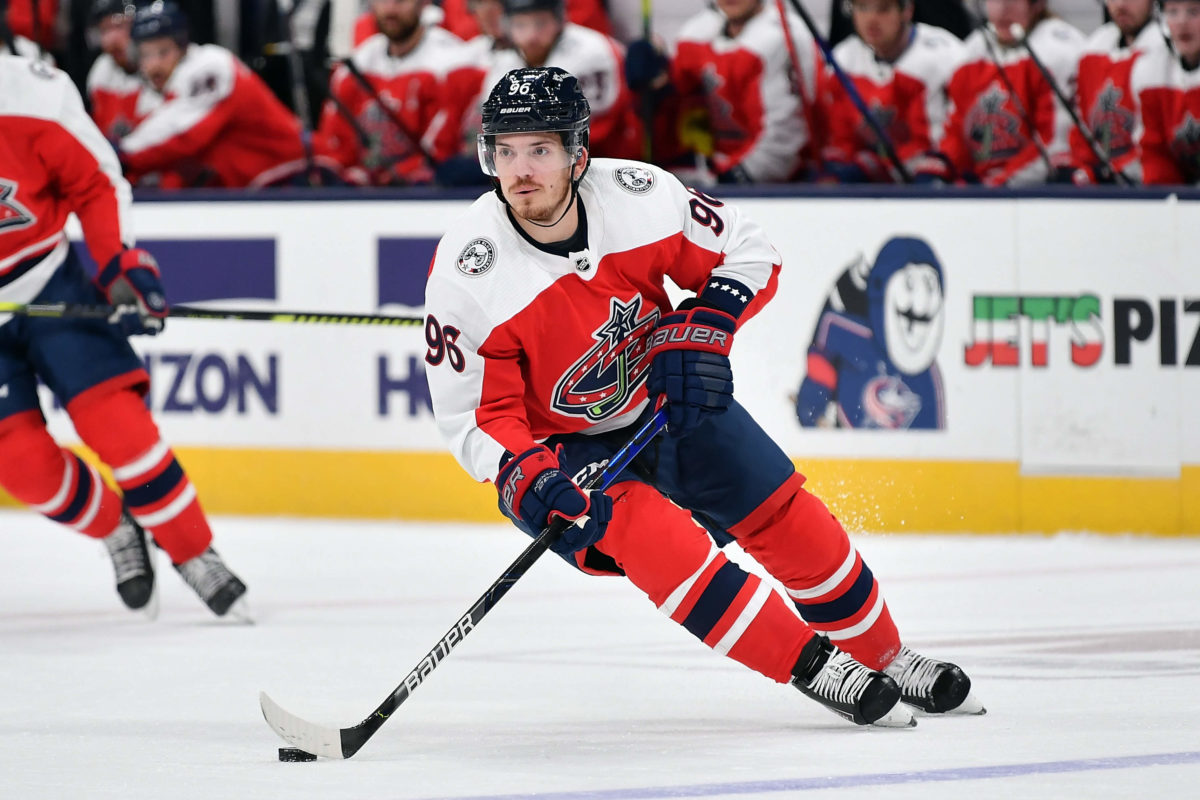
Roslovic is a natural center, but he has a long way to go before he can be considered to be an NHL center. His faceoff percentage was among the worst in the league among players who took at least 100 draws. However, he did show substantial improvement toward the end of the season. Likewise, his defensive play came closer to passing the “eye test” in the season’s final month.
Kevin Stenlund: C
Stenlund played in only 32 games during the 2020-21 season and scored only 10 points (five goals, five assists) while skating an average of 12:32 per game. Nothing really stood out about his game at any point in the season.
Alexandre Texier: D
Texier had a hot start to the 2020-21 season but basically fell off a cliff afterward. Three goals and four points in the first four games! One goal and 10 assists in the next 45 games! He also looked out of place playing center for much of the campaign. Is he a center or a wing in the NHL? Is he one of the players who will benefit most from a coaching change?
The Part-Time Players in 2020-21
Ten more forwards played for the Blue Jackets during the 2020-21 season. None of them saw action in even half of the games and none scored more than a handful of points. However, several forwards should be in the upper part of this list after next season, including Liam Foudy, Emil Bemstrom, and perhaps Zac Dalpe and Josh Dunne. Time will tell.